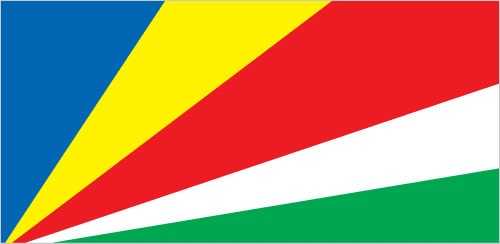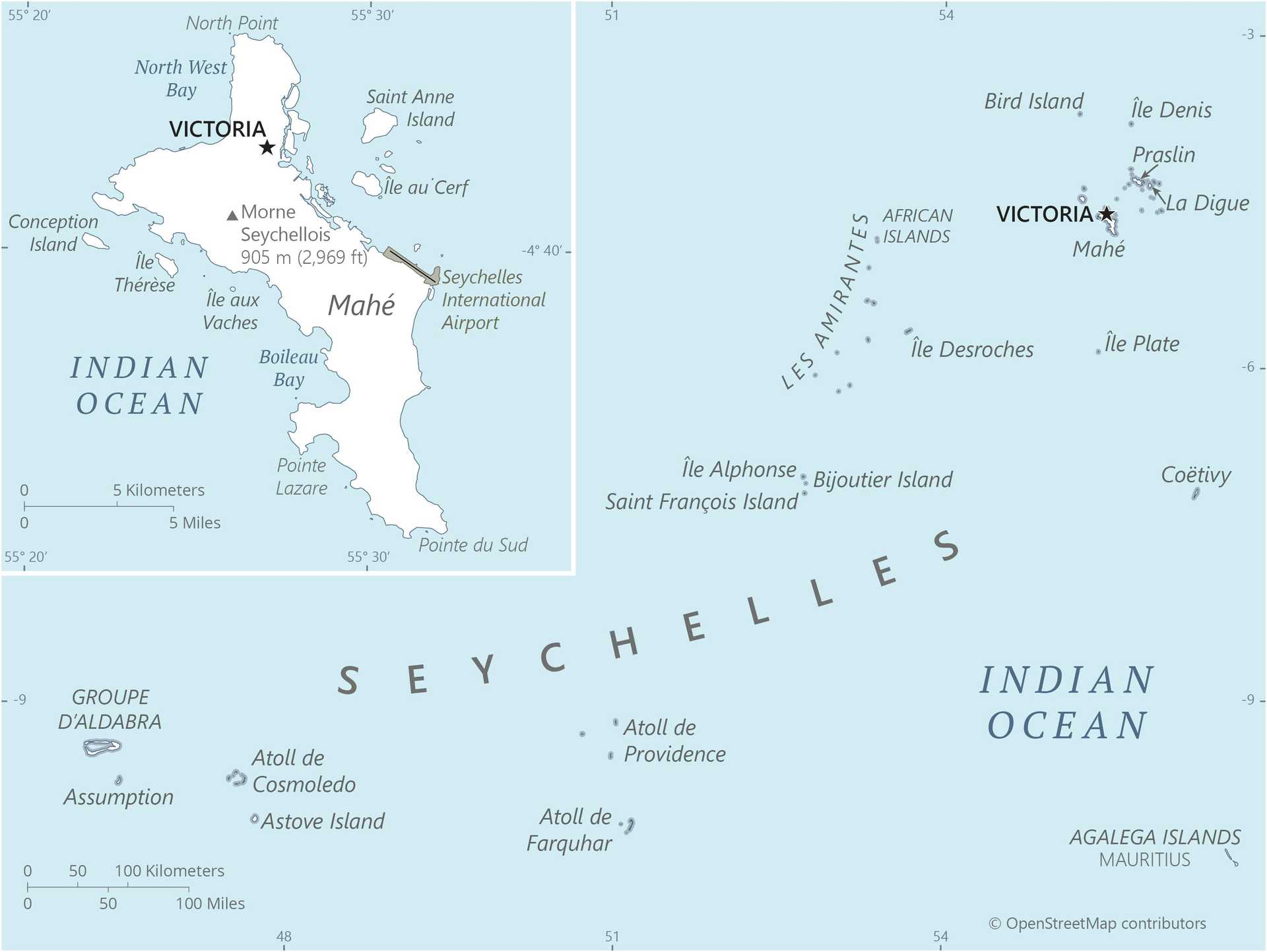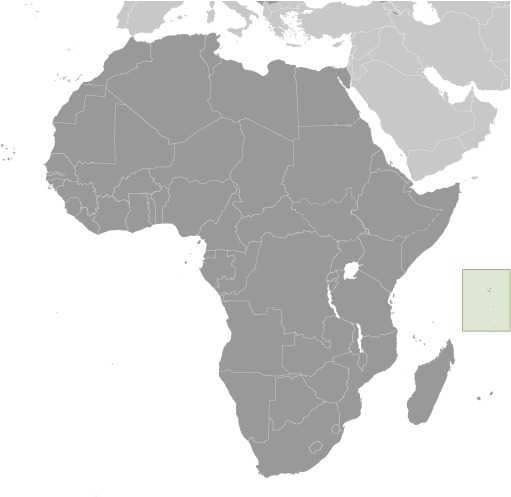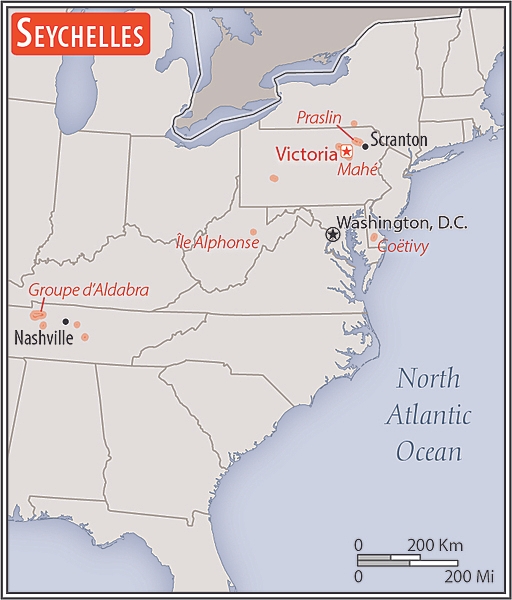Introduction
Background
Seychelles was uninhabited before Europeans discovered the islands early in the 16th century. After a lengthy struggle, France eventually ceded control of the islands to Great Britain in 1814. During colonial rule, a plantation-based economy developed that relied on imported labor, primarily from European colonies in Africa. Seychelles gained independence in 1976 through negotiations with Great Britain. In 1977, Prime Minister France-Albert RENE launched a coup against the country’s first president, and Seychelles became a socialist one-party state until adopting a new constitution and holding elections in 1993. RENE continued to lead Seychelles through two election cycles until he stepped down in 2004. Vice President James Alix MICHEL took over the presidency and in 2006 was elected to a new five-year term; he was reelected in 2011 and again in 2015. In 2016, James MICHEL resigned and handed over the presidency to his vice-president, Danny FAURE. In 2020, Wavel RAMKALAWAN was elected president, the first time an opposition candidate has won the presidency.
Visit the Definitions and Notes page to view a description of each topic.
Geography
Location
archipelago in the Indian Ocean, northeast of Madagascar
Geographic coordinates
4 35 S, 55 40 E
Map references
Africa
Land boundaries
total: 0 km
Coastline
491 km
Maritime claims
territorial sea: 12 nm
contiguous zone: 24 nm
exclusive economic zone: 200 nm
continental shelf: 200 nm or to the edge of the continental margin
Climate
tropical marine; humid; cooler season during southeast monsoon (late May to September); warmer season during northwest monsoon (March to May)
Terrain
Mahe Group is volcanic with a narrow coastal strip and rocky, hilly interior; others are relatively flat coral atolls, or elevated reefs; sits atop the submarine Mascarene Plateau
Elevation
highest point: Morne Seychellois 905 m
lowest point: Indian Ocean 0 m
Natural resources
fish, coconuts (copra), cinnamon trees
Land use
agricultural land: 6.5% (2018 est.)
arable land: 2.2% (2018 est.)
permanent crops: 4.3% (2018 est.)
permanent pasture: 0% (2018 est.)
forest: 88.5% (2018 est.)
other: 5% (2018 est.)
Irrigated land
3 sq km (2012)
Population distribution
more than three-quarters of the population lives on the main island of Mahe; Praslin contains less than 10%; a smaller percent on La Digue and the outer islands as shown in this population distribution map
Natural hazards
lies outside the cyclone belt, so severe storms are rare; occasional short droughts
Geography - note
the smallest African country in terms of both area and population; the constitution of the Republic of Seychelles lists 155 islands, 42 granitic and 113 coralline; by far the largest island is Mahe, which is home to about 90% of the population and the site of the capital city of Victoria
People and Society
Population
total: 98,187
male: 50,973
female: 47,214 (2024 est.)
comparison rankings: female 197; male 194; total 197
Nationality
noun: Seychellois (singular and plural)
adjective: Seychellois
Ethnic groups
predominantly Creole (mainly of East African and Malagasy heritage); also French, Indian, Chinese, and Arab populations
Languages
Seychellois Creole (official) 89.1%, English (official) 5.1%, French (official) 0.7%, other 3.8%, unspecified 1.4% (2010 est.)
Religions
Roman Catholic 76.2%, Protestant 10.5% (Anglican 6.1%, Pentecostal Assembly 1.5%, Seventh Day Adventist 1.2%, other Protestant 1.7%), other Christian 2.4%, Hindu 2.4%, Muslim 1.6%, other non-Christian 1.1%, unspecified 4.8%, none 0.9% (2010 est.)
Demographic profile
Seychelles has no indigenous population and was first permanently settled by a small group of French planters, African slaves, and South Indians in 1770. Seychelles’ modern population is composed of the descendants of French and later British settlers, Africans, and Indian, Chinese, and Middle Eastern traders and is concentrated on three of its 155 islands – the vast majority on Mahe and lesser numbers on Praslin and La Digue. Seychelles’ population grew rapidly during the second half of the 20th century, largely due to natural increase, but the pace has slowed because of fertility decline. The total fertility rate dropped sharply from 4.0 children per woman in 1980 to 1.9 in 2015, mainly as a result of a family planning program, free education and health care, and increased female labor force participation. Life expectancy has increased steadily, but women on average live 9 years longer than men, a difference that is higher than that typical of developed countries.
The combination of reduced fertility and increased longevity has resulted in an aging population, which will put pressure on the government’s provision of pensions and health care. Seychelles’ sustained investment in social welfare services, such as free primary health care and education up to the post-secondary level, have enabled the country to achieve a high human development index score – among the highest in Africa. Despite some of its health and education indicators being nearly on par with Western countries, Seychelles has a high level of income inequality.
An increasing number of migrant workers – mainly young men – have been coming to Seychelles in recent years to work in the construction and tourism industries. As of 2011, foreign workers made up nearly a quarter of the workforce. Indians are the largest non-Seychellois population – representing half of the country’s foreigners – followed by Malagasy.
Age structure
0-14 years: 17.7% (male 8,912/female 8,439)
15-64 years: 72.4% (male 37,841/female 33,210)
65 years and over: 10% (2024 est.) (male 4,220/female 5,565)
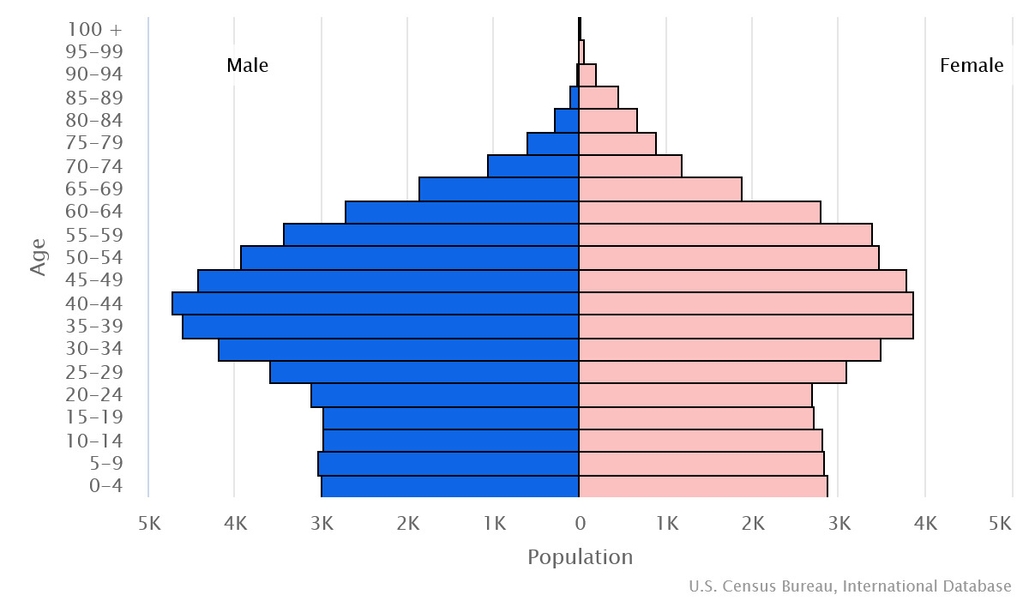
Dependency ratios
total dependency ratio: 45
youth dependency ratio: 33.6
elderly dependency ratio: 11.4
potential support ratio: 8.7 (2021 est.)
Median age
total: 38.7 years (2024 est.)
male: 38.2 years
female: 39.4 years
comparison ranking: total 71
Population distribution
more than three-quarters of the population lives on the main island of Mahe; Praslin contains less than 10%; a smaller percent on La Digue and the outer islands as shown in this population distribution map
Urbanization
urban population: 58.8% of total population (2023)
rate of urbanization: 0.99% annual rate of change (2020-25 est.)
Major urban areas - population
28,000 VICTORIA (capital) (2018)
Sex ratio
at birth: 1.03 male(s)/female
0-14 years: 1.06 male(s)/female
15-64 years: 1.14 male(s)/female
65 years and over: 0.76 male(s)/female
total population: 1.08 male(s)/female (2024 est.)
Infant mortality rate
total: 10.2 deaths/1,000 live births (2024 est.)
male: 12.8 deaths/1,000 live births
female: 7.4 deaths/1,000 live births
comparison ranking: total 131
Life expectancy at birth
total population: 76.6 years (2024 est.)
male: 72.2 years
female: 81.1 years
comparison ranking: total population 105
Gross reproduction rate
0.89 (2024 est.)
Drinking water source
improved: urban: NA
rural: NA
total: 96.2% of population
unimproved: urban: NA
rural: NA
total: 3.8% of population (2017 est.)
Current health expenditure
6.4% of GDP (2020)
Physician density
2.25 physicians/1,000 population (2019)
Hospital bed density
3.6 beds/1,000 population (2011)
Sanitation facility access
improved: urban: NA
rural: NA
total: 100% of population
unimproved: urban: NA
rural: NA
total: 0% of population (2020 est.)
Alcohol consumption per capita
total: 9.48 liters of pure alcohol (2019 est.)
beer: 4.11 liters of pure alcohol (2019 est.)
wine: 0.49 liters of pure alcohol (2019 est.)
spirits: 4.62 liters of pure alcohol (2019 est.)
other alcohols: 0.25 liters of pure alcohol (2019 est.)
comparison ranking: total 28
Tobacco use
total: 20.2% (2020 est.)
male: 34% (2020 est.)
female: 6.4% (2020 est.)
comparison ranking: total 87
Currently married women (ages 15-49)
45% (2023 est.)
Literacy
definition: age 15 and over can read and write
total population: 95.9%
male: 95.4%
female: 96.4% (2018)
School life expectancy (primary to tertiary education)
total: 15 years
male: 13 years
female: 16 years (2021)
Environment
Environment - current issues
water supply depends on catchments to collect rainwater; water pollution; biodiversity maintainance
Environment - international agreements
party to: Biodiversity, Climate Change, Climate Change-Kyoto Protocol, Climate Change-Paris Agreement, Comprehensive Nuclear Test Ban, Desertification, Endangered Species, Hazardous Wastes, Law of the Sea, Marine Dumping-London Convention, Nuclear Test Ban, Ozone Layer Protection, Ship Pollution, Wetlands
signed, but not ratified: none of the selected agreements
Climate
tropical marine; humid; cooler season during southeast monsoon (late May to September); warmer season during northwest monsoon (March to May)
Land use
agricultural land: 6.5% (2018 est.)
arable land: 2.2% (2018 est.)
permanent crops: 4.3% (2018 est.)
permanent pasture: 0% (2018 est.)
forest: 88.5% (2018 est.)
other: 5% (2018 est.)
Urbanization
urban population: 58.8% of total population (2023)
rate of urbanization: 0.99% annual rate of change (2020-25 est.)
Air pollutants
particulate matter emissions: 16.96 micrograms per cubic meter (2019 est.)
carbon dioxide emissions: 0.61 megatons (2016 est.)
methane emissions: 0.1 megatons (2020 est.)
Waste and recycling
municipal solid waste generated annually: 48,000 tons (2012 est.)
Total water withdrawal
municipal: 10 million cubic meters (2020 est.)
industrial: 3.8 million cubic meters (2017 est.)
agricultural: 900,000 cubic meters (2017 est.)
Total renewable water resources
0 cubic meters (2017 est.)
Government
Country name
conventional long form: Republic of Seychelles
conventional short form: Seychelles
local long form: Republic of Seychelles
local short form: Seychelles
etymology: named by French Captain Corneille Nicholas MORPHEY after Jean Moreau de SECHELLES, the finance minister of France, in 1756
Government type
presidential republic
Capital
name: Victoria
geographic coordinates: 4 37 S, 55 27 E
time difference: UTC+4 (9 hours ahead of Washington, DC, during Standard Time)
etymology: founded as L'etablissement in 1778 by French colonists, the town was renamed in 1841 by the British after Queen VICTORIA (1819-1901); "victoria" is the Latin word for "victory"
Administrative divisions
27 administrative districts; Anse aux Pins, Anse Boileau, Anse Etoile, Anse Royale, Au Cap, Baie Lazare, Baie Sainte Anne, Beau Vallon, Bel Air, Bel Ombre, Cascade, Glacis, Grand Anse Mahe, Grand Anse Praslin, Ile Perseverance I, Ile Perseverance II, La Digue, La Riviere Anglaise, Les Mamelles, Mont Buxton, Mont Fleuri, Plaisance, Pointe Larue, Port Glaud, Roche Caiman, Saint Louis, Takamaka
Independence
29 June 1976 (from the UK)
National holiday
Constitution Day, 18 June (1993); Independence Day (National Day), 29 June (1976)
Constitution
history: previous 1970, 1979; latest drafted May 1993, approved by referendum 18 June 1993, effective 23 June 1993
amendments: proposed by the National Assembly; passage requires at least two-thirds majority vote by the National Assembly; passage of amendments affecting the country’s sovereignty, symbols and languages, the supremacy of the constitution, fundamental rights and freedoms, amendment procedures, and dissolution of the Assembly also requires approval by at least 60% of voters in a referendum; amended several times, last in 2018
Legal system
mixed legal system of English common law, French civil law, and customary law
International law organization participation
has not submitted an ICJ jurisdiction declaration; accepts ICCt jurisdiction
Citizenship
citizenship by birth: no
citizenship by descent only: at least one parent must be a citizen of the Seychelles
dual citizenship recognized: no
residency requirement for naturalization: 5 years
Suffrage
18 years of age; universal
Executive branch
chief of state: President Wavel RAMKALAWAN (since 26 October 2020)
head of government: President Wavel RAMKALAWAN (since 26 October 2020)
cabinet: Council of Ministers appointed by the president
elections/appointments: president directly elected by absolute majority popular vote in 2 rounds if needed for a 5-year term (eligible for a second term); election last held on 22 to 24 October 2020 (next to be held in 2025)
election results:
2020: Wavel RAMKALAWAN elected president; Wavel RAMKALAWAN (LDS) 54.9%, Danny FAURE (US) 43.5%, other 1.6%
2015: President James Alix MICHEL reelected president in second round; percent of vote in first round - James Alix MICHEL (PL) 47.8%, Wavel RAMKALAWAN (SNP) 35.3%, other 16.9%; percent of vote in second round - James Alix MICHEL 50.2%, Wavel RAMKALAWAN 49.8%
note: the president is both chief of state and head of government
Legislative branch
description: unicameral National Assembly or Assemblee Nationale (35 seats in the 2020-25 term; 26 members directly elected in single-seat constituencies by simple majority vote and up to 9 members elected by proportional representation vote; members serve 5-year terms)
elections: last held on 22-24 October 2020 (next to be held in October 2025); note - the election was originally scheduled for 2021 but was moved up a year and held alongside the presidential election in order to cut election costs
election results: percent of vote by party - LDS 54.8%, US 42.3%, other 2.9%; seats by party - LDS 25, US 10; composition - men 27, women 7, percentage women 20.6%
Judicial branch
highest court(s): Seychelles Court of Appeal (consists of the court president and 4 justices); Supreme Court of Seychelles (consists of the chief justice and 9 puisne judges); Constitutional Court (consists of 3 Supreme Court judges)
judge selection and term of office: all judges appointed by the president of the republic upon the recommendation of the Constitutional Appointments Authority, a 3-member body, with 1 member appointed by the president of the republic, 1 by the opposition leader in the National Assembly, and 1 by the other 2 appointees; judges serve until retirement at age 70
subordinate courts: Magistrates' Courts of Seychelles; Family Tribunal for issues such as domestic violence, child custody, and maintenance; Employment Tribunal for labor-related disputes
Political parties and leaders
Seychelles Party for Social Justice and Democracy or SPSJD [Vesna RAKIC]
Seychellois Democratic Alliance or LDS (Linyon Demokratik Seselwa/Union Démocratique Seychelloise) (coalition includes SNP and SPSJD) [Roger MANCIENNE]
Seychelles National Party or SNP [Wavel RAMKALAWAN]
United Seychelles or US [Patrick HERMINIE]
International organization participation
ACP, AfDB, AOSIS, AU, C, CD, COMESA, EITI (candidate country), FAO, G-77, IAEA, IBRD, ICAO, ICC (NGOs), ICCt, ICRM, IDA, IFAD, IFC, IFRCS, ILO, IMF, IMO, InOC, Interpol, IOC, IOM, IPU, ISO (correspondent), ITU, MIGA, NAM, OIF, OPCW, SADC, UN, UNCTAD, UNESCO, UNIDO, UNWTO, UPU, WCO, WHO, WIPO, WMO, WTO
Diplomatic representation in the US
chief of mission: Ambassador Ian Dereck Joseph MADELEINE (since 1 December 2021); note - also Permanent Representative to the UN
chancery: 685 Third Avenue, Suite 1107, 11th Floor, New York, NY 10017
telephone: [1] (212) 972-1785
FAX: [1] (212) 972-1786
email address and website: seychellesmission@sycun.org
Foreign Affairs Department Republic of Seychelles » United States of America (mfa.gov.sc)
Diplomatic representation from the US
chief of mission: Ambassador Henry V. JARDINE (since 22 February 2023); Chargé d’Affaires Adham LOUTFI (since 6 October 2023) note - Ambassador JARDINE is posted in Mauritius and is accredited to Seychelles, and Chargé d’Affaires LOUTFI is posted in Victoria, Seychelles to manage the expanding policy interests
embassy: 2nd Floor, Oliaji Trade Center, Victoria Mahe, Seychelles; note - US Embassy in Seychelles reopened on 1 June 2023 after having been closed in 1996
telephone: [248] 422 5256
Flag description
five oblique bands of blue (hoist side), yellow, red, white, and green (bottom) radiating from the bottom of the hoist side; the oblique bands are meant to symbolize a dynamic new country moving into the future; blue represents sky and sea, yellow the sun giving light and life, red the peoples' determination to work for the future in unity and love, white social justice and harmony, and green the land and natural environment
National symbol(s)
coco de mer (sea coconut); national colors: blue, yellow, red, white, green
National anthem
name: "Koste Seselwa" (Seychellois Unite)
lyrics/music: David Francois Marc ANDRE and George Charles Robert PAYET
note: adopted 1996
National heritage
total World Heritage Sites: 2 (both natural)
selected World Heritage Site locales: Aldabra Atoll; Vallée de Mai Nature Reserve
Economy
Economic overview
high-income Indian Ocean island economy; rapidly growing tourism sector; major tuna exporter; offshore financial hub; environmentally fragile and investing in ocean rise mitigation; recently discovered offshore oil potential; successful anticorruption efforts
Real GDP (purchasing power parity)
$3.53 billion (2023 est.)
$3.421 billion (2022 est.)
$2.976 billion (2021 est.)
note: data in 2021 dollars
comparison ranking: 194
Real GDP growth rate
3.16% (2023 est.)
14.98% (2022 est.)
0.55% (2021 est.)
note: annual GDP % growth based on constant local currency
comparison ranking: 105
Real GDP per capita
$29,500 (2023 est.)
$28,500 (2022 est.)
$30,000 (2021 est.)
note: data in 2021 dollars
comparison ranking: 80
GDP (official exchange rate)
$2.141 billion (2023 est.)
note: data in current dollars at official exchange rate
Inflation rate (consumer prices)
8.28% (2020 est.)
2.07% (2019 est.)
3.7% (2018 est.)
note: annual % change based on consumer prices
comparison ranking: 159
Credit ratings
Fitch rating: B+ (2020)
note: The year refers to the year in which the current credit rating was first obtained.
GDP - composition, by sector of origin
agriculture: 2.5% (2017 est.)
industry: 13.8% (2017 est.)
services: 83.7% (2017 est.)
comparison rankings: services 23; industry 188; agriculture 160
GDP - composition, by end use
household consumption: 52.7% (2017 est.)
government consumption: 34.4% (2017 est.)
investment in fixed capital: 26.7% (2017 est.)
investment in inventories: 0% (2017 est.)
exports of goods and services: 79.4% (2017 est.)
imports of goods and services: -93.2% (2017 est.)
Agricultural products
coconuts, vegetables, bananas, eggs, chicken, pork, fruits, tomatoes, tropical fruits, cassava (2022)
note: top ten agricultural products based on tonnage
Industries
fishing, tourism, beverages
Industrial production growth rate
2.13% (2023 est.)
note: annual % change in industrial value added based on constant local currency
comparison ranking: 115
Youth unemployment rate (ages 15-24)
total: 16.5% (2020 est.)
male: 17.5%
female: 15.6%
comparison ranking: total 104
Population below poverty line
25.3% (2018 est.)
note: % of population with income below national poverty line
Gini Index coefficient - distribution of family income
32.1 (2018 est.)
note: index (0-100) of income distribution; higher values represent greater inequality
comparison ranking: 130
Household income or consumption by percentage share
lowest 10%: 2.6% (2018 est.)
highest 10%: 23.9% (2018 est.)
note: % share of income accruing to lowest and highest 10% of population
Remittances
0.49% of GDP (2023 est.)
0.49% of GDP (2022 est.)
0.64% of GDP (2021 est.)
note: personal transfers and compensation between resident and non-resident individuals/households/entities
Budget
revenues: $601 million (2019 est.)
expenditures: $586 million (2019 est.)
Public debt
63.6% of GDP (2017 est.)
69.1% of GDP (2016 est.)
60.91% of GDP (2015 est.)
note: central government debt as a % of GDP
comparison ranking: 70
Taxes and other revenues
26.18% (of GDP) (2020 est.)
note: central government tax revenue as a % of GDP
comparison ranking: 40
Current account balance
-$155.194 million (2023 est.)
-$141.648 million (2022 est.)
-$160.168 million (2021 est.)
note: balance of payments - net trade and primary/secondary income in current dollars
comparison ranking: 104
Exports
$2.375 billion (2023 est.)
$2.247 billion (2022 est.)
$1.751 billion (2021 est.)
note: balance of payments - exports of goods and services in current dollars
comparison ranking: 160
Exports - partners
UAE 18%, France 17%, UK 9%, Mauritius 9%, Japan 8% (2022)
note: top five export partners based on percentage share of exports
Exports - commodities
fish, refined petroleum, ships, aircraft, animal meal (2022)
note: top five export commodities based on value in dollars
Imports
$2.437 billion (2023 est.)
$2.298 billion (2022 est.)
$1.821 billion (2021 est.)
note: balance of payments - imports of goods and services in current dollars
comparison ranking: 167
Imports - partners
UAE 22%, Netherlands 14%, Cayman Islands 7%, France 6%, China 6% (2022)
note: top five import partners based on percentage share of imports
Imports - commodities
ships, refined petroleum, fish, plastic products, cars (2022)
note: top five import commodities based on value in dollars
Reserves of foreign exchange and gold
$638.961 million (2022 est.)
$702.585 million (2021 est.)
$559.682 million (2020 est.)
note: holdings of gold (year-end prices)/foreign exchange/special drawing rights in current dollars
comparison ranking: 157
Exchange rates
Seychelles rupees (SCR) per US dollar -
Exchange rates:
14.273 (2022 est.)
16.921 (2021 est.)
17.617 (2020 est.)
14.033 (2019 est.)
13.911 (2018 est.)
Energy
Electricity access
electrification - total population: 100% (2022 est.)
Electricity
installed generating capacity: 158,000 kW (2022 est.)
consumption: 571.297 million kWh (2022 est.)
transmission/distribution losses: 44.034 million kWh (2022 est.)
comparison rankings: transmission/distribution losses 37; consumption 172; installed generating capacity 178
Electricity generation sources
fossil fuels: 86.1% of total installed capacity (2022 est.)
solar: 12.9% of total installed capacity (2022 est.)
wind: 1% of total installed capacity (2022 est.)
Coal
imports: (2022 est.) less than 1 metric ton
Petroleum
refined petroleum consumption: 6,000 bbl/day (2022 est.)
Carbon dioxide emissions
867,000 metric tonnes of CO2 (2022 est.)
from petroleum and other liquids: 867,000 metric tonnes of CO2 (2022 est.)
comparison ranking: total emissions 173
Communications
Telephones - fixed lines
total subscriptions: 19,000 (2022 est.)
subscriptions per 100 inhabitants: 18 (2022 est.)
comparison ranking: total subscriptions 175
Telephones - mobile cellular
total subscriptions: 205,000 (2022 est.)
subscriptions per 100 inhabitants: 192 (2022 est.)
comparison ranking: total subscriptions 183
Telecommunication systems
general assessment: effective system; direct international calls to over 100 countries; radiotelephone communications between islands in the archipelago; 3 ISPs; use of Internet cafes' for access to Internet; 4G services and 5G pending (2020)
domestic: fixed-line is 18 per 100 and mobile-cellular teledensity is 173 telephones per 100 persons (2021)
international: country code - 248; landing points for the PEACE and the SEAS submarine cables providing connectivity to Europe, the Middle East, Africa and Asia; direct radiotelephone communications with adjacent island countries and African coastal countries; satellite earth station - 1 Intelsat (Indian Ocean) (2019)
Broadcast media
the national broadcaster, Seychelles Broadcasting Corporation (SBC), which is funded by taxpayer money, operates the only terrestrial TV station, which provides local programming and airs broadcasts from international services; a privately owned Internet Protocol Television (IPTV) channel also provides local programming multi-channel cable and satellite TV are available through 2 providers; the national broadcaster operates 1 AM and 1 FM radio station; there are 2 privately operated radio stations; transmissions of 2 international broadcasters are accessible in Victoria
(2019)Internet users
total: 90,200 (2021 est.)
percent of population: 82% (2021 est.)
comparison ranking: total 190
Broadband - fixed subscriptions
total: 34,966 (2020 est.)
subscriptions per 100 inhabitants: 36 (2020 est.)
comparison ranking: total 148
Transportation
National air transport system
number of registered air carriers: 1 (2020)
inventory of registered aircraft operated by air carriers: 7
annual passenger traffic on registered air carriers: 455,201 (2018)
annual freight traffic on registered air carriers: 7.79 million (2018) mt-km
Heliports
6 (2024)
Merchant marine
total: 30 (2023)
by type: general cargo 6, oil tanker 6, other 18
comparison ranking: total 134
Ports
total ports: 1 (2024)
large: 0
medium: 0
small: 0
very small: 1
ports with oil terminals: 1
key ports: Victoria
Military and Security
Military and security forces
Seychelles Defense Forces (SDF): Army (includes infantry, special forces, and a presidential security unit), Coast Guard, and Air Force
Ministry of Internal Affairs: Seychelles Police Force (includes unarmed police and an armed paramilitary Police Special Support Wing, and the Marine Police Unit) (2024)
note: the SDF reports to the president, who acts as minister of defense
Military expenditures
1.6% of GDP (2023 est.)
1.4% of GDP (2022 est.)
1.5% of GDP (2021 est.)
1.6% of GDP (2020 est.)
1.3% of GDP (2019 est.)
comparison ranking: 83
Military and security service personnel strengths
approximately 500-1,000 personnel (2023)
Military equipment inventories and acquisitions
the SDF's inventory primarily consists of Soviet-era equipment delivered in the 1970s and 1980s; in recent years, the SDF has received limited amounts of more modern equipment, mostly donations of patrol boats and aircraft, from several suppliers led by China and India (2023)
Military service age and obligation
18-28 (18-25 for officers) years of age for voluntary military service for men and women; 6-year initial commitment; no conscription (2023)
Military - note
formed in 1977, the SDF is one of the World's smallest militaries; its primary responsibility is maritime security, particularly countering illegal fishing, piracy, and drug smuggling; it was given police powers in 2022; the Seychelles has close security ties with India (2023)

